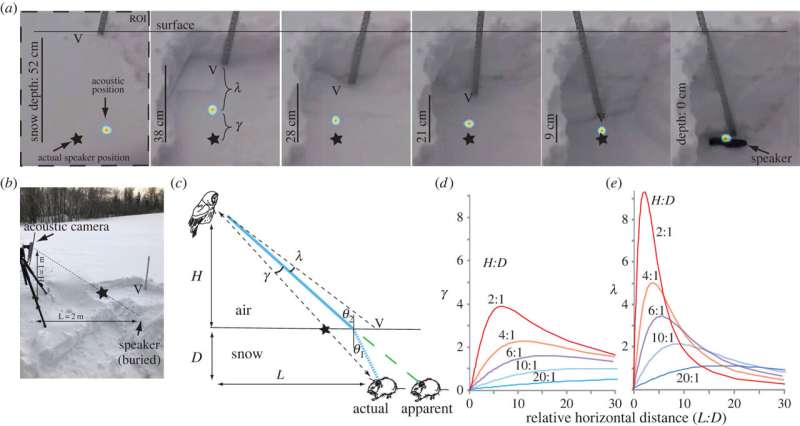Snow refracts sound, thus at certain angles the owl perceives an ‘acoustic mirage’: the acoustic position is offset from the actual source position. (a) The acoustic position of sound (heat map) changes with snow depth, due to refraction. V: vertical location above loudspeaker. Star: actual location of loudspeaker. Beamforming settings: 1/3 octave bandwidth centered on 2.0 kHz, 1 second integration time (beamforming corresponds to black rectangles in figure 2a). Images have been cropped from the full camera image to show the ROI as defined in the BeamformX software. (b) Experimental set-up; snow depth = 38 cm (top 14 cm of snow already removed). (c) Geometry of the model: L: length of the horizontal distance from sound source. D: depth of the sound source below snow. H: height above snow. V and star indicate two possible attack strategies. Blue line shows path of sound refracted at the air–snow interface; green dashed line shows apparent location. (d,e) Error angles γ and λ as a function of L, D, and H. Data shown in (a) correspond to H:D = 2.6, L:D = 5.2. The actual hunting strategy of Great Gray Owls is to approach prey at H:D ratios of > 10:1. Credit: Proceedings of the Royal Society B: Biological Sciences (2022). DOI: 10.1098/rspb.2022.1164
A trio of researchers from the University of California, Discover Owls and the University of Washington has discovered how great gray owls are able to find and capture voles under two feet of snow. In their paper published in Proceedings of the Royal Society B, Christopher Clark, James Duncan and Robert Dougherty describe using acoustic cameras to spatially locate sound sources under the snow.
Prior research has shown that great gray owls are able to detect the presence of prey, such as rabbits and voles, under deep blankets of snow. Once found, the owls are able to swoop down and push their feet and legs through the snow to capture their prey. In this new effort, the researchers sought to figure out how they do it.
The work involved venturing into the forests of Manitoba, Canada, which is covered every winter by a thick blanket of snow. They looked for, and found, plunge holes, evidence of owls plunging into the snow and grabbing prey—in this case, mostly voles. They then dug similar holes next to those they found and buried speakers under the snow.
They set up acoustic cameras that were capable of recording a wide range of sound in the vicinity of the buried speakers. The researchers then played sounds from the speakers and measured what was audible through the snow using the microphones on the acoustic cameras. As they did so, they slowly removed layers of snow covering the speakers to learn more about which sounds were able to penetrate which amounts of snow.
Video from Great Gray Owls hunting voles under snow hover to defeat an acoustic mirage. Credit: Proceedings of the Royal Society B: Biological Sciences (2022). DOI: 10.1098/rspb.2022.1164
They found that white noise was able to penetrate thin layers of snow, but only very low-frequency noise was able to penetrate deep snow. The researchers note that great gray owls have large, round faces with feathers that reflect sound, making it possible for them to hear low-frequency sounds, such as those made by voles digging through snow.
The researchers also noted that the birds generally circled over an intended target for a few seconds before diving—a means, the researchers noted, for overcoming problems with sound refracting as it passed through the snow.
More information: Christopher J. Clark et al, Great Gray Owls hunting voles under snow hover to defeat an acoustic mirage, Proceedings of the Royal Society B: Biological Sciences (2022). DOI: 10.1098/rspb.2022.1164
Journal information: Proceedings of the Royal Society B
© 2022 Science X Network
























